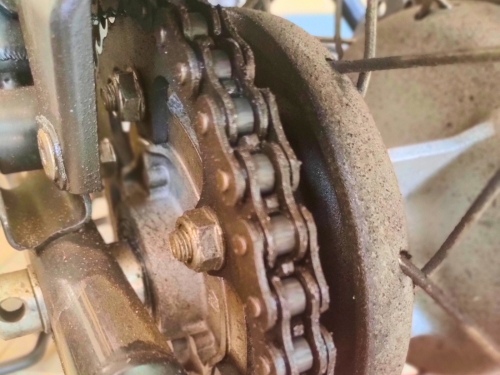
|
Getting your Trinity Audio player ready...
|
Long story short, a clean motorcycle chain is essential to motorcycle maintenance and should be maintained between 500 and 600 km. Along with that, the motorcycle chain should be maintained at the same intervals. Here, we dive into the bike chain types and step-by-step instructions for maintaining the motorcycle chain properly.
Key Takeaways
- Regular motorcycle chain maintenance ensures smooth power transfer, improves performance and enhances durability. Lubricate every 500 km for a safer ride.
- Two-wheeler chains include Roller, O-ring, and X-ring types. O-ring and X-ring chains provide better durability with less maintenance.
- Use a centre or paddock stand, clean the chain with a cleanser, scrub with a brush, and wipe with a microfiber cloth. Rotate the rear wheel while spraying chain lube evenly, avoiding excess lubrication.
- Replace the chain and sprockets if the chain pulls off the rear sprocket easily or if the sprocket teeth are worn and pointed. Always replace both together for optimal performance.
- Check for worn sprockets, uneven tension, excessive slack, rust, noise, kinked links, damaged O-rings, frequent lubrication needs, stretching, or dryness. Inspect and replace the chain and sprockets immediately if any signs appear.
Importance of Motorcycle chain
Cleaning motorcycle chains is something that owners take less care of, and it needs at least lubrication every 500 km. Maintaining a motorcycle chain is so simple that it is DIY with only a few required tools. The basic principle behind the power transfer of a two-wheeler is the transmission of power from the engine to the rear wheel via a chain with the help of a sprocket. This applies to all motorcycles; some models might have different chains.
Suppose a chain play is loose, too tight, or dirty. In that case, it affects the smooth transfer of power and performance. The chain is the primary device that transfers power from the engine to the rear wheel. If the motorcycle chain is poorly maintained, the bike’s performance can take a toll. You can now realize the importance of two-wheeler chain maintenance in a motorcycle.
Types of two-wheeler chain
We must observe the three types of drive chains to understand their differences.
- Roller chain: There is no extra ring between the outer and inner roller link plates. The standard non-O-Ring chains are the drive chains in older motorcycles and some of our latest small-capacity motorbikes. The standard roller chains are also non-self-lubricating and need to be lubricated regularly.
- O-ring chain: An extra ring in the shape of an o is between the outer and inner roller link plate. These O-rings are between chain plates to seal the already vacuum-filled grease between the rollers and the other internal components of the chain. This mechanism of O-Ring type chains makes them self-lubricated. Hence, they require less maintenance and have a longer life and better performance in the long run.
- X-ring chain: An extra ring in the shape of an x is present between the outer roller link plate and the inner roller link plate. The X-ring type chains are more modern chains with X-shaped rubber rings between the chain plates to seal the grease-filled inside the chain components. These types of rings come in contact with lesser surface area upon pressing. Hence, a lower drag coefficient is generated with the same efficient sealing property that O-ring chains provide.
Tools needed for cleaning the chain
How to clean motorcycle chain?
- First things first – Do not start the engine at any time while cleaning the chain, and never put the finger anywhere near the chain.
- Keep the motorcycle on a centre stand and make sure it is stable. If no centre stand is available, use a paddock stand. Keep the vehicle off the side stand.
- Overall, clean the motorcycle with water and ensure the surrounding area is clean.
- Now use a chain cleanser and allow it to soak in for 10 minutes. Please note that while using a chain cleaner, rotate the chain continuously.
- Use a chain cleaning brush and repeatedly clean until the chain is silver. Next, use a microfibre cloth to remove the remaining dirt from the chain.
- Start rotating the rear wheel, take the chain lubricant, keep the nozzle close to the chain, and start spraying. Make sure each chain link is lubed.
- Do not overuse the lubricant or wash the motorcycle after lubrication.
Source: Royal Enfield Youtube
How to maintain motorcycle chain?
- Clean and lubricate chain every 500-600kms
- Check for chain slack by referring to the owner’s manual and adjusting as per instructions given in the manual.
- The chain should be tight enough, as this will result in improper power transmission from the engine.
- Use grease instead of chain lube spray for long rides, as the grease stays longer.
When should we replace the motorcycle chain and chain sprocket?
First, tension the chain properly according to your owner’s manual. Pinch the chain with your thumb and forefinger at about 2–3 o’clock on the rear drive sprocket of the rear wheel. Pull the chain in the rearward direction. If the chain pulls off the chain sprocket significantly and quickly, it’s time to change the chain and sprockets. Regarding the chain sprocket, if the teeth are not parallel and pointed, it will cause damage and wear to the chain, so replace the chain sprocket immediately. One thing to note is to replace the chain and chain sprocket together, not as separate.
Benefits of cleaning and maintaining motorcycle chain
- Longer chain life
- Improve gear shift performance
- Prevents corrosion and reduces friction
- Improves mileage
How to Check and Adjust Motorcycle Chain
1. Inspection Process
Visual Inspection
Before diving into the adjustment process, start with a thorough visual inspection of your motorcycle chain:
- Look for signs of wear, damage, rust, or missing links.
- Check for proper lubrication, as a well-lubricated chain is essential for optimal performance and longevity.
Measuring Chain Slack
Chain slack is a critical aspect of chain maintenance. Here’s how to measure it:
- Position your motorcycle on a centre or paddock stand to ensure stability and safety during the inspection.
- Locate the midpoint between the front and rear sprockets.
- Measure the chain’s vertical movement at this point. The typical slack range is 25-30mm but always refer to your motorcycle’s manual for the exact specifications.
2. Adjustment Procedure
Locating the Tight Spot
Before adjusting, it’s essential to find the chain’s tightest point:
- Rotate the rear wheel slowly and observe the chain tension.
- Identify the spot where the chain is tightest.
Adjusting Chain Tension
Once you’ve located the tight spot, follow these steps to adjust the chain tension:
- Use essential tools like a crescent wrench and pliers for the adjustment process.
- Adjust the chain tension at the tightest spot to the minimum specification in your motorcycle’s manual.
- After adjustment, check the slack at the loosest point to ensure it doesn’t exceed the maximum specification.
Ensuring Proper Alignment
Proper chain alignment is crucial for optimal performance and longevity:
- Don’t rely solely on the hatch marks on axle blocks or swingarm for alignment.
- Use a dedicated chain alignment tool for more accurate results.
3. Lubrication
- Position your motorcycle on a centre or paddock stand to ensure stability and safety during the inspection.
- Locate the midpoint between the front and rear sprockets.
- Measure the chain’s vertical movement at this point. The typical slack range is 25-30mm but always refer to your motorcycle’s manual for the exact specifications.
2. Adjustment Procedure
Locating the Tight Spot
Before adjusting, it’s essential to find the chain’s tightest point:
- Rotate the rear wheel slowly and observe the chain tension.
- Identify the spot where the chain is tightest.
Adjusting Chain Tension
Once you’ve located the tight spot, follow these steps to adjust the chain tension:
- Use essential tools like a crescent wrench and pliers for the adjustment process.
- Adjust the chain tension at the tightest spot to the minimum specification in your motorcycle’s manual.
- After adjustment, check the slack at the loosest point to ensure it doesn’t exceed the maximum specification.
Ensuring Proper Alignment
Proper chain alignment is crucial for optimal performance and longevity:
- Don’t rely solely on the hatch marks on axle blocks or swingarm for alignment.
- Use a dedicated chain alignment tool for more accurate results.
3. Lubrication
- Rotate the rear wheel slowly and observe the chain tension.
- Identify the spot where the chain is tightest.
Adjusting Chain Tension
Once you’ve located the tight spot, follow these steps to adjust the chain tension:
- Use essential tools like a crescent wrench and pliers for the adjustment process.
- Adjust the chain tension at the tightest spot to the minimum specification in your motorcycle’s manual.
- After adjustment, check the slack at the loosest point to ensure it doesn’t exceed the maximum specification.
Ensuring Proper Alignment
Proper chain alignment is crucial for optimal performance and longevity:
- Don’t rely solely on the hatch marks on axle blocks or swingarm for alignment.
- Use a dedicated chain alignment tool for more accurate results.
3. Lubrication
- Use essential tools like a crescent wrench and pliers for the adjustment process.
- Adjust the chain tension at the tightest spot to the minimum specification in your motorcycle’s manual.
- After adjustment, check the slack at the loosest point to ensure it doesn’t exceed the maximum specification.
Ensuring Proper Alignment
Proper chain alignment is crucial for optimal performance and longevity:
- Don’t rely solely on the hatch marks on axle blocks or swingarm for alignment.
- Use a dedicated chain alignment tool for more accurate results.
3. Lubrication
- Don’t rely solely on the hatch marks on axle blocks or swingarm for alignment.
- Use a dedicated chain alignment tool for more accurate results.
3. Lubrication
Regular lubrication is essential, especially considering India’s environmental factors:
- Lubricate your chain every 300-500 km for optimal performance.
- SAE90W gear oil is recommended as an effective lubricant for both O-ring and X-ring type chains.
- In dusty conditions or during monsoon seasons, you may need to lubricate more frequently to combat environmental effects.
4. Safety Precautions
Always prioritize safety when working on your motorcycle:
- Wear safety glasses and nitrile gloves to protect against debris and chemicals.
- Ensure your bike is on a firm surface to prevent tipping or falling.
- Never run the bike in gear while cleaning or lubricating the chain to avoid accidents.
5. Common Mistakes to Avoid
Be aware of these common pitfalls in chain maintenance:
- Over-tightening the chain can lead to premature wear of sprockets and chains.
- Neglecting regular inspections. Aim to inspect your chain about twice a month or every 500-700 miles.
- Ignore wear patterns on the sprocket. Look for even wear, cracks, and missing teeth, which indicate improper tension or alignment.
What specific signs should a rider look for to determine if the motorcycle chain needs immediate attention in India?
Here are the key indicators that a motorcycle chain requires immediate attention:
1. Visible Wear on Sprockets
One of the most obvious signs is visible damage to the sprockets. If the teeth on the sprockets appear hooked or worn down, it clearly indicates that both the chain and sprockets need replacing. This wear can be accelerated in India due to road dust and grit, which act as abrasives.
2. Uneven Chain Tension
India’s varied road conditions, including many uneven surfaces, can rapidly affect chain tension. If the chain exhibits uneven tightness or if it’s difficult to adjust it within the recommended tension range, it suggests that both the chain and sprockets should be replaced. This is particularly important given the stress placed on the chain by India’s road conditions.
3. Excessive Chain Slack
The constant jarring and movement caused by uneven road surfaces in India can lead to misalignment and increased wear, resulting in excessive slack. A chain with excessive slack or loose pins is a sign of wear that needs immediate attention, as it can affect the bike’s performance and safety.
4. Rust and Corrosion
Given India’s monsoon season and high humidity in many regions, rust and corrosion are significant concerns. Excessive rust, kinks, stiffness, and abnormal rattling noises all show that the chain needs to be replaced immediately. Riders should be especially vigilant for rust after the monsoon season or in coastal areas.
5. Noisy Chain
A worn chain often becomes noisy and may require more frequent lubrication. In India’s dusty conditions, this noise can be more pronounced as dust and grit accumulate on the chain, increasing friction and wear. If the chain is consistently noisy despite lubrication, it’s a sign that immediate attention is needed.
6. Binding or Kinked Links
Binding or kinked links can indicate severe wear or damage. India’s dusty roads and uneven surfaces exacerbate this issue, leading to uneven power delivery and prompt attention.
7. Damaged O-rings
Close examination of the chain may reveal damaged O-rings, especially in areas where the chain measures longer per link. In India’s hot climate, O-rings can deteriorate more quickly, making this a crucial sign to watch.
8. Frequent Lubrication Needs
If the chain requires lubrication more frequently, it could be a sign of wear than usual. In India’s climate, where heat can cause lubricants to break down quickly and dust can wash away lubricants, this sign may require more attention.
9. Visible Stretching
Perform the chain pull test by grabbing the chain at the rear sprocket’s rearmost part and trying to pull it away. If the chain pulls away significantly, it indicates wear and needs immediate attention. This test is particularly relevant in India, where combining heat, dust, and uneven roads can accelerate chain stretching.
10. Discolouration or Dryness
In India’s hot climate, chain lubricants can evaporate quickly. If the chain appears dry or discoloured, especially after riding in dusty conditions, it’s a sign that immediate lubrication and possibly replacement are needed.
FAQ about how to maintain the motorcycle chain
1. Are motorcycle chain guards necessary?
Motorcycle chain guards extend the cleaning period of a chain. If the chain is naked, the cleaning interval is much less and needs more frequent maintenance. When the bike chain guard is there, it protects from debris, sand, and dirt and increases the cleaning interval.
2. Are all bike chains the same?
No, several motorcycle chains are ringed according to ring type: X-ring chain, O-ring chain, and roller chain.
3. Are all bike chain driven?
No, belts are also used instead of chains by some motorcycle companies like Harley Davidson.
4. Does motorcycle chain lube expire?
Typically, most motorcycle chain lube can last up to 500 km in normal conditions. When conditions are extreme, 200-250 km chain lubing is recommended.
5. Can a two-wheeler chain be loose or tight?
No, motorcycle chains cannot be loose or tight, and the chain slack should be as mentioned in the service manual.
6. Can I clean the motorcycle chain with WD 40?
Yes. However, it is recommended to use chain cleaner first and chain lube afterwards. There are dedicated products for chain cleaning, and WD 40 is an all-purpose product. So, it is better to use a reliable chain cleaner.
7. Can you clean the motorcycle chain with kerosene?
Kerosene can be used to remove hard grease stains. But we recommend using a professional chain cleaner instead of kerosene.
8. Can I adjust the motorcycle chain on the sidestand?
No. A motorcycle chain adjustment is generally not recommended when the bike is on the side stand. This is because the bike’s weight is not evenly distributed on the side stand, which can affect the accuracy of the chain slack measurement.
Additionally, adjusting the chain on the side stand can stress the chain and sprockets more, leading to premature wear and tear. It is best to change the motorcycle chain while on a centre stand or lift. This will ensure that the chain is evenly tensioned and that the measurement is accurate.
9. How to clean a motorcycle chain without a stand?
Use a paddock stand in case the motorcycle does not have a centre stand. Never clean the bike chain on a side stand.
10. How to lube a bike chain without a stand?
Use a paddock stand in case the motorcycle does not have a centre stand. Never lube the bike chain on a side stand.
11. Where to apply two-wheeler chain lube?
Motorcycle chain lube should be applied to all four sides of the chain and the sprockets. The best way to do this is to hold a piece of cardboard behind the chain as you rotate the wheel, spraying lubricant onto the chain as it moves.
12. Will a new bike chain stretch?
Yes, a new motorcycle chain will stretch slightly over time. This is due to the wear and tear of the pins and rollers that make up the chain. The amount of stretch will vary depending on the type of chain, the riding conditions, and the chain maintenance. However, replacing the chain after stretching it by about 1/2 to 3/4 of an inch is generally recommended.
13. Can a bike chain be too tight?
If the chain slack is too tight, it can wear out prematurely and cause other problems with the drivetrain.
14. Can a bike chain be too loose?
The chain slack can jump off the sprockets if it is too loose.
Other related articles from Bikeleague India Team
- Top 10 proven tips to increase two wheeler mileage
- Bike maintenance at home
- Motorcycle service – All things you need to know explained
- The Ultimate Guide to Motorcycle Suspension: Everything You Need to Know
- Joy E-Bikes
Conclusion
In-depth, we have discussed the critical aspects of cleaning and maintaining the motorcycle chain in this article. If you have any other doubts or queries, email us at bikeleague2017@gmail.com or share your doubts or opinions in the comments section below. We are always eager to help and assist you. Also, here are several social media platforms of Bikeleague India to raise your suspicions.

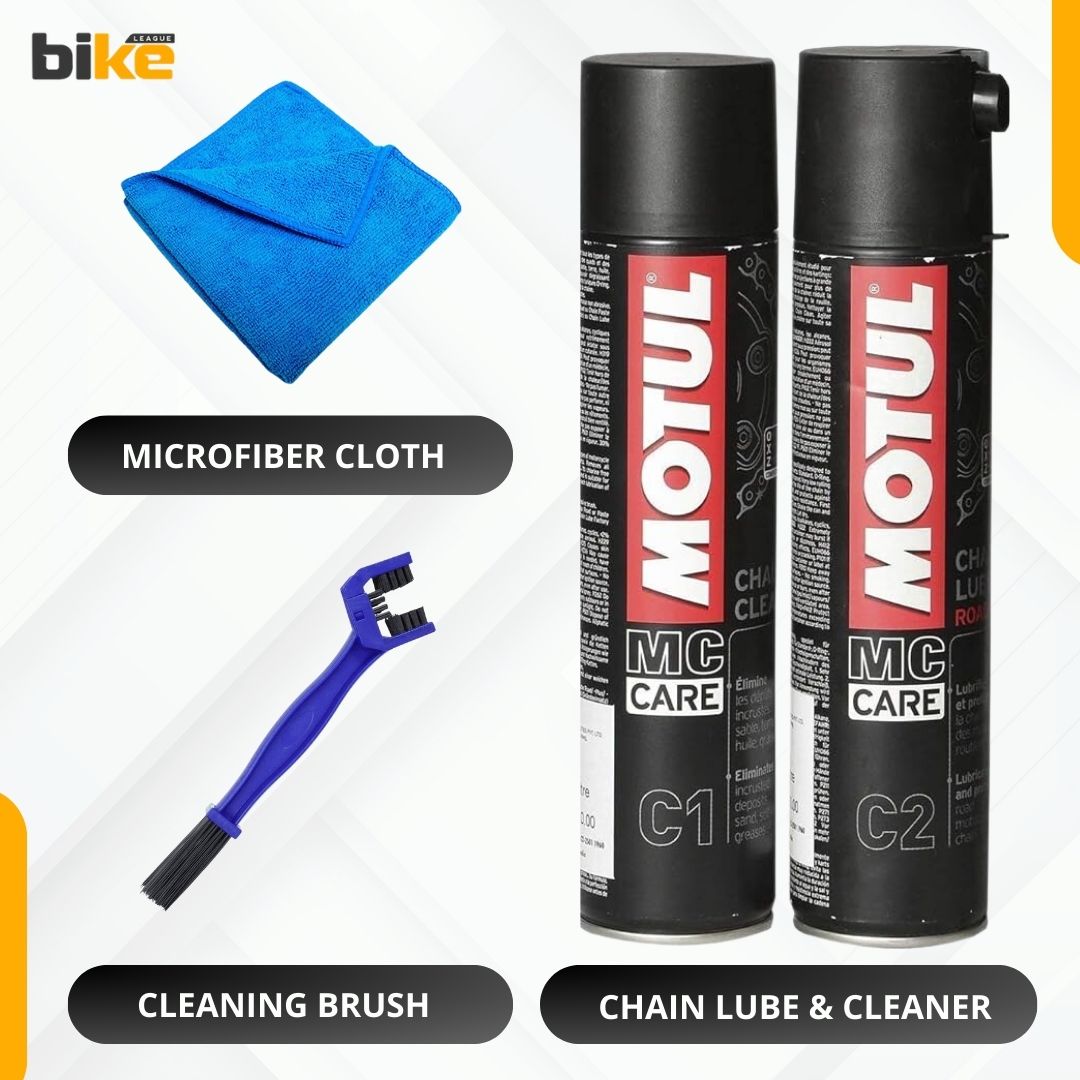
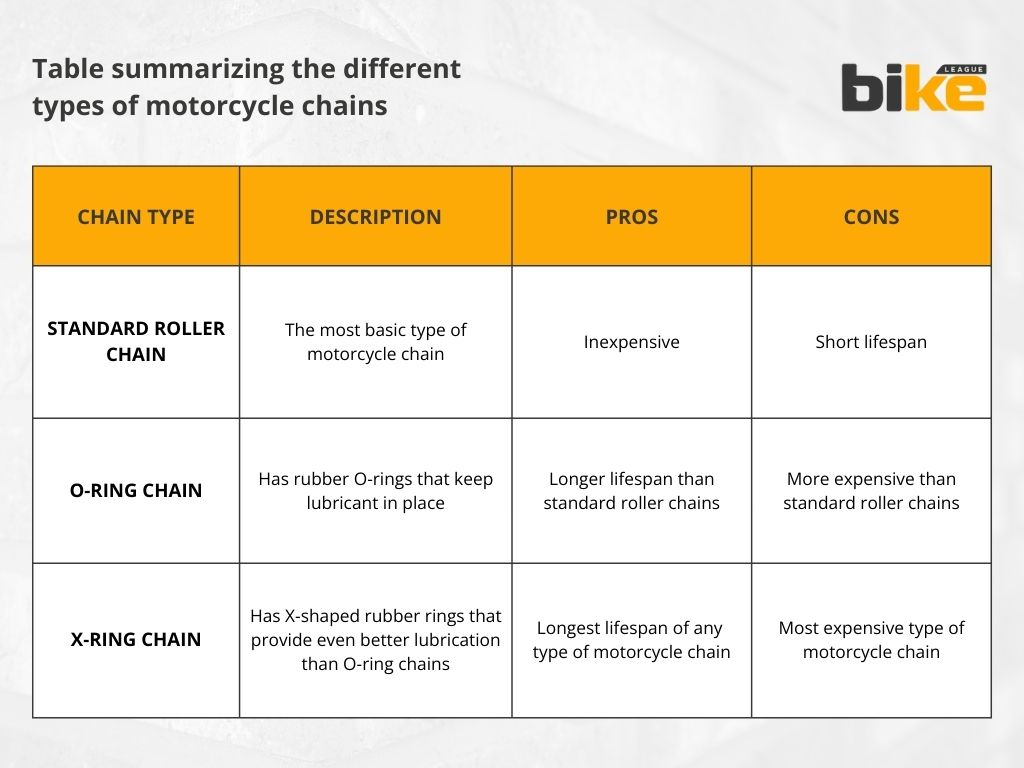
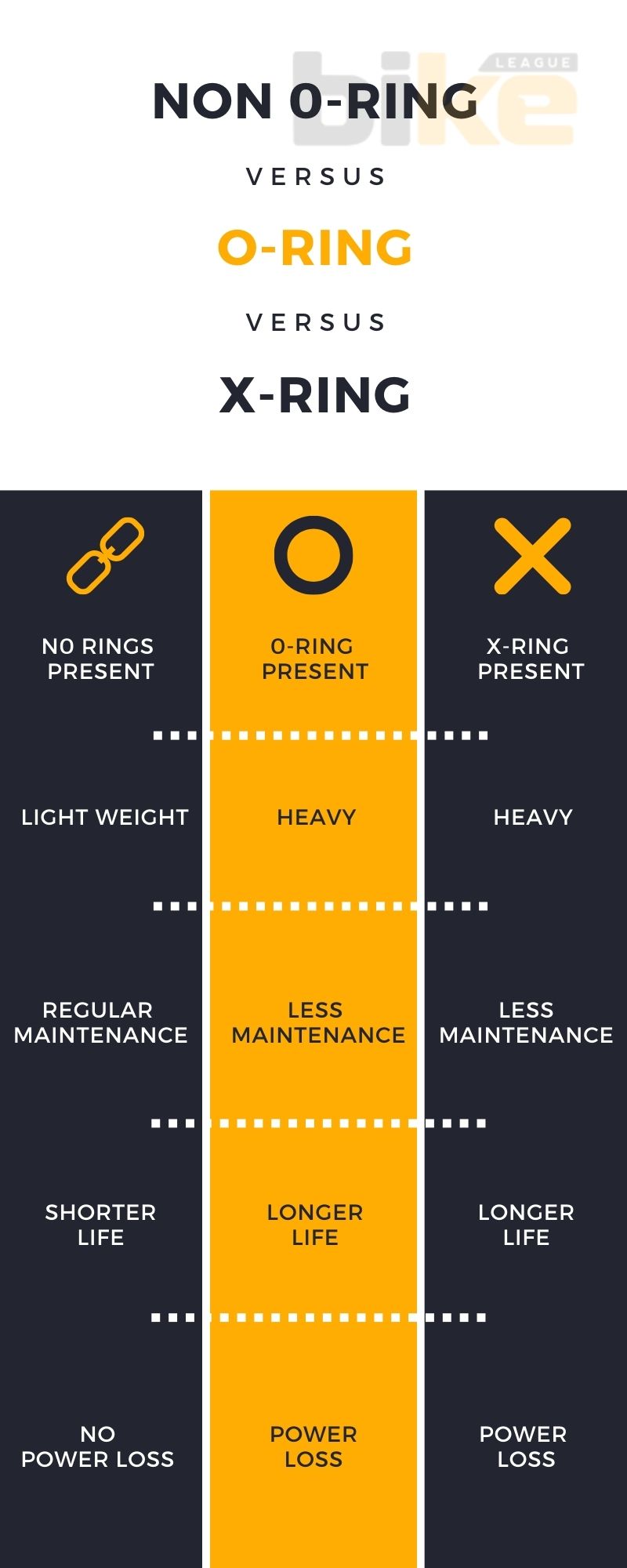

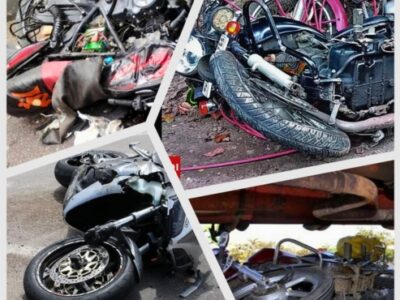
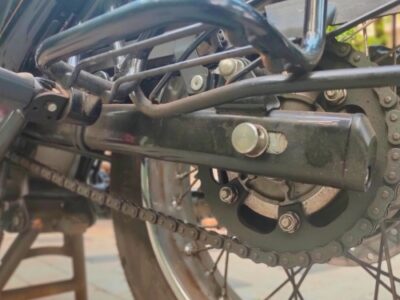
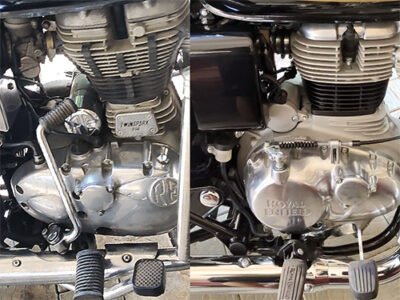
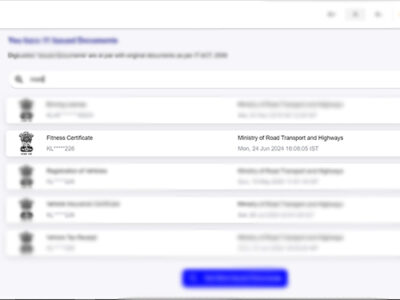
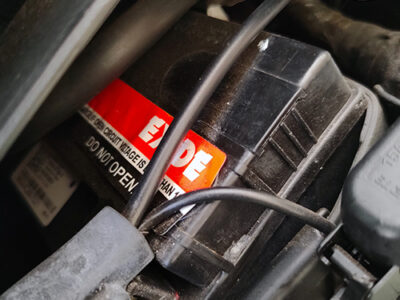
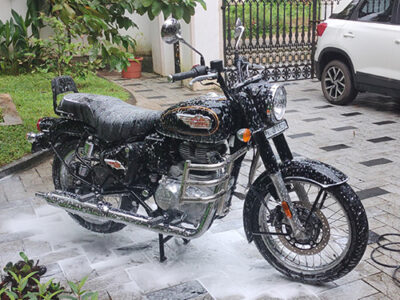
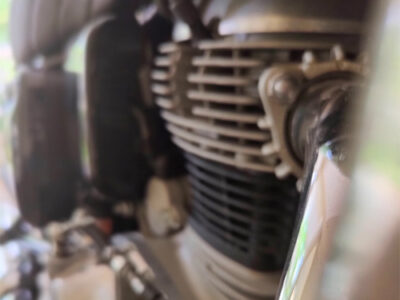
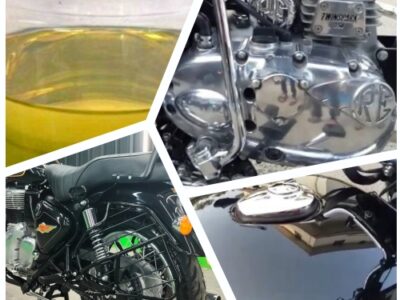
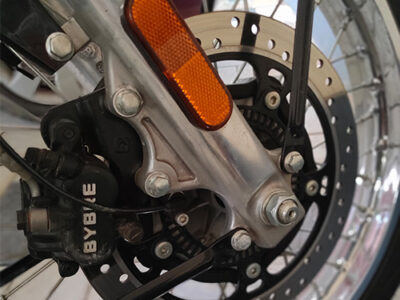
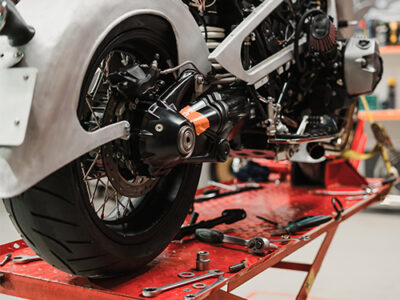
“Great article! Chain maintenance is crucial for a smooth and safe ride, and this guide breaks it down really well. I’ve found that using a dedicated chain brush makes cleaning much easier and more effective. Also, applying chain lube after a ride rather than before helps with better absorption. Do you have any specific brand recommendations for chain cleaners and lubricants? Thanks for sharing these useful tips!”
Thank you for the kind reply
You can opt for brands like Motul and Motorcycle specific chain lube products for the same.